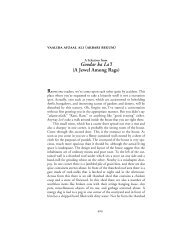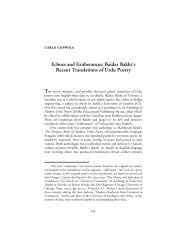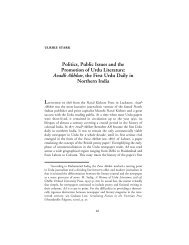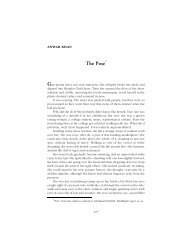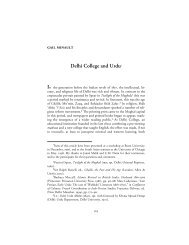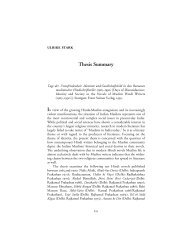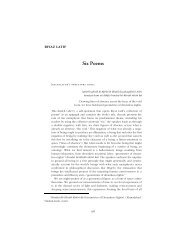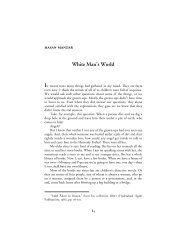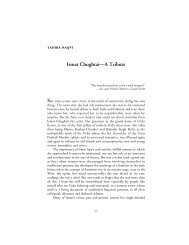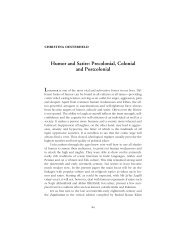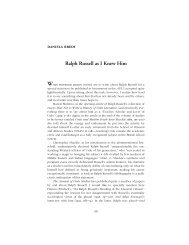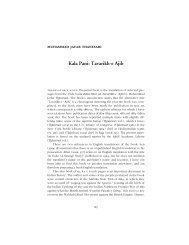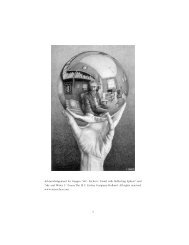Form or Mere Illusion?* - the Annual of Urdu Studies
Form or Mere Illusion?* - the Annual of Urdu Studies
Form or Mere Illusion?* - the Annual of Urdu Studies
- No tags were found...
Create successful ePaper yourself
Turn your PDF publications into a flip-book with our unique Google optimized e-Paper software.
Muhammad Hasan Askari • 7back, puts two centimes in his hand and smiles. Time was when love was<strong>the</strong> essence <strong>of</strong> life. Jules Laf<strong>or</strong>gue (1860–1887), on <strong>the</strong> o<strong>the</strong>r hand, consideredwomen merely wild animals who trapped <strong>the</strong>ir mate and moanedwith <strong>the</strong>móall f<strong>or</strong> a three-minute <strong>or</strong>gasm! He congratulates himself tha<strong>the</strong> did not become a slave to his desire like everyone else; ra<strong>the</strong>r, heresisted it and never embraced <strong>or</strong> kissed a woman in his life.Such <strong>the</strong>n is <strong>the</strong> condition <strong>of</strong> <strong>the</strong> new artist. Regardless what col<strong>or</strong> <strong>or</strong>f<strong>or</strong>m attachment might assume, he is altoge<strong>the</strong>r free <strong>of</strong> it, 3 not because <strong>of</strong>some l<strong>of</strong>ty purpose <strong>or</strong> monkish self-denial, but ra<strong>the</strong>r because freedomfrom attachment gives his spirit a sense <strong>of</strong> exaltation. He is compelled todissociate himself from all human attachments and m<strong>or</strong>al considerationsbecause materialist values have c<strong>or</strong>rupted <strong>the</strong> very institutions that are <strong>the</strong>manifestations <strong>of</strong> <strong>the</strong>se basic relationships. The new artist sees everythingaround him poised against goodness, truth, and beautyóhis true gods.The contemp<strong>or</strong>ary situation disillusions him to <strong>the</strong> point where he feelsobliged to distance himself even from <strong>the</strong> very subjects <strong>of</strong> his poetry, <strong>the</strong>wellspring <strong>of</strong> his art, namely, human and m<strong>or</strong>al relationships. He cannotaccept <strong>the</strong> values that are current and popular in his society, and lacks <strong>the</strong>power to have society accept his own. Hence he looks at everything withskepticism and flees from anything that might be dubbed good <strong>or</strong> bad,true <strong>or</strong> false. His o<strong>the</strong>r affliction is that in spite <strong>of</strong> his unflinching attachmentto his own values, he is not so insensitive <strong>or</strong> unimaginative as toconsider <strong>the</strong>m necessarily above <strong>or</strong> superi<strong>or</strong> to every o<strong>the</strong>r. So, he tries, inwhatever way he can, to steer clear <strong>of</strong> <strong>the</strong> conundrum <strong>of</strong> values altoge<strong>the</strong>rand spare himself <strong>the</strong> need to answer questions about <strong>the</strong> truth <strong>or</strong> falsehood,<strong>the</strong> goodness <strong>or</strong> badness <strong>of</strong> anything, perhaps because his answersmight not satisfy even him. His tendency to doubt and his uncertaintymight appear to be signs <strong>of</strong> m<strong>or</strong>al decay, but if new artists lack <strong>the</strong> selfassurance<strong>of</strong> sheep and cattle, <strong>the</strong>re is at least one man who does not feels<strong>or</strong>ry f<strong>or</strong> that at all.The spiritual problems and <strong>the</strong> disillusionment <strong>of</strong> <strong>the</strong>se artists cannotbe brushed aside nonchalantly. Never<strong>the</strong>less, a purely artistic problemdoes arise: a person may abandon ethical n<strong>or</strong>ms, but is it possible to createa piece <strong>of</strong> art without such n<strong>or</strong>msówhe<strong>the</strong>r it is conscious <strong>or</strong> unconsciousis beside <strong>the</strong> point? There has to be some kind <strong>of</strong> connection andrelationship between <strong>the</strong> parts and <strong>the</strong> whole <strong>of</strong> an artistic w<strong>or</strong>k, as <strong>the</strong>reshould be a relationship between <strong>the</strong> w<strong>or</strong>k and those it affects. Fur<strong>the</strong>r,this relationship must be rooted in some standard.āzādast.3 Allusion to a line from <strong>the</strong> Persian poet Ḥāfi: Ze har če rañg taʿalluq pezīrad



